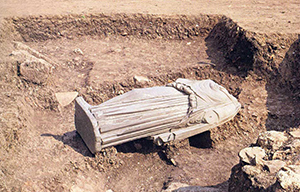Η βασιλική παρουσία στις Αιγές
Παλαιά και νέα ευρήματα της ανασκαφής του Αριστοτέλειου Πανεπιστημίου Θεσσαλονίκης στη Βεργίνα
Χρυσούλα Σαατσόγλου-Παλιαδέλη
Ομότιμη Καθηγήτρια Κλασικής Αρχαιολογίας, Αριστοτέλειο Πανεπιστήμιο Θεσσαλονίκης - Διευθύντρια Πανεπιστημιακής Ανασκαφής στη Βεργίνα
 Η απώλεια του Μανόλη Ανδρόνικου στις 31 Μαρτίου του 1992, 27 χρόνια από σήμερα, άφησε ένα μεγάλο κενό στην αρχαιολογική οικογένεια, το οποίο οι άμεσοι συνεργάτες του ανέλαβαν να αναπληρώσουν, συνεχίζοντας την πανεπιστημιακή ανασκαφή, ασκώντας τους φοιτητές τους στην ανασκαφική πρακτική, δημοσιεύοντας ή δημοσιοποιώντας τα ευρήματά τους και ακολουθώντας, με κάθε δυνατό τρόπο, τα δικά του βήματα για την ασφάλεια, τη συντήρηση, την κατανόηση, την προβολή και τη σημασία τους. Το άρθρο αυτό, που δημοσιεύεται στο παρόν τεύχος των «Θεμάτων Αρχαιολογίας», αφιερωμένο στη μνήμη του, είναι η ελάχιστη προσωπική τιμή για τον δάσκαλο, κυρίως όμως για τη δικαίωση του επιστήμονα, οι ερμηνείες του οποίου επαληθεύονται σταδιακά με μεγαλύτερη βεβαιότητα, χάρις όχι μόνον στα ευρήματα από τους τομείς που πρόλαβε να γνωρίσει, αλλά κυρίως από τα νεώτερα που έχουν έλθει στο φως, ή εκείνα που εξετάζονται εκ νέου και ισχυροποιούν τις απόψεις του.
Η απώλεια του Μανόλη Ανδρόνικου στις 31 Μαρτίου του 1992, 27 χρόνια από σήμερα, άφησε ένα μεγάλο κενό στην αρχαιολογική οικογένεια, το οποίο οι άμεσοι συνεργάτες του ανέλαβαν να αναπληρώσουν, συνεχίζοντας την πανεπιστημιακή ανασκαφή, ασκώντας τους φοιτητές τους στην ανασκαφική πρακτική, δημοσιεύοντας ή δημοσιοποιώντας τα ευρήματά τους και ακολουθώντας, με κάθε δυνατό τρόπο, τα δικά του βήματα για την ασφάλεια, τη συντήρηση, την κατανόηση, την προβολή και τη σημασία τους. Το άρθρο αυτό, που δημοσιεύεται στο παρόν τεύχος των «Θεμάτων Αρχαιολογίας», αφιερωμένο στη μνήμη του, είναι η ελάχιστη προσωπική τιμή για τον δάσκαλο, κυρίως όμως για τη δικαίωση του επιστήμονα, οι ερμηνείες του οποίου επαληθεύονται σταδιακά με μεγαλύτερη βεβαιότητα, χάρις όχι μόνον στα ευρήματα από τους τομείς που πρόλαβε να γνωρίσει, αλλά κυρίως από τα νεώτερα που έχουν έλθει στο φως, ή εκείνα που εξετάζονται εκ νέου και ισχυροποιούν τις απόψεις του.
Λέξεις ευρετηρίου: Βεργίνα, Αιγές, Αρχαία Μακεδονία, Ευρυδίκη Σίρρα, Φιλιππείον
COPYRIGHT: © Θέματα Αρχαιολογίας, 2018 - ISSN 2653-9292
Επικοινωνία με την συγγραφέα: cspal@hist.auth.gr
Το πρωτότυπο άρθρο βρίσκεται στη βιβλιοθήκη του περιοδικού Θέματα Αρχαιολογίας
![]()
Αυτό το άρθρο χορηγείται με άδεια Creative Commons Αναφορά Δημιουργού-Μη Εμπορική Χρήση-Όχι Παράγωγα Έργα 4.0 Διεθνές .
The royal presence at Aigai
Old and new excavation finds of the Aristotle University of Thessaloniki at Vergina
Chrysoula Saatsoglou-Paliadeli
Emeritus Professor of Classical Archaeology Aristotle University Thessaloniki, Greece - Director of Excavations at Vergina
 The article reconsiders old and presents recent material evidence which reflects the presence of royalties at the archaeological site of Vergina, and thus certifies its identification with the old capital of the ancient Macedonian kingdom. Originally suggested by the British historian, N.G.L.Hammond, in 1968, Aegae would have remained a possibility, were it not for the systematic excavation of the site, operated by the Aristotle University of Thessaloniki, since 1938. In 1976, Prof. Man. Andronikos decided to complete his investigation of the greatest among the hundreds of tumuli he had already excavated in the previous decades; the material evidence revealed on the upper levels of the Great Tumulus, during that year, supported Hammond’s suggestion, and foresaw the impressive finds which were revealed in the next four years. The expansion of the excavation in the area between the palace and the cemetery of the fortified ancient city, which is still operated by the Aristotle University, has endowed us with rich material evidence, vindicating the identification of the site with the old capital of the ancient Macedonian kingdom.
The article reconsiders old and presents recent material evidence which reflects the presence of royalties at the archaeological site of Vergina, and thus certifies its identification with the old capital of the ancient Macedonian kingdom. Originally suggested by the British historian, N.G.L.Hammond, in 1968, Aegae would have remained a possibility, were it not for the systematic excavation of the site, operated by the Aristotle University of Thessaloniki, since 1938. In 1976, Prof. Man. Andronikos decided to complete his investigation of the greatest among the hundreds of tumuli he had already excavated in the previous decades; the material evidence revealed on the upper levels of the Great Tumulus, during that year, supported Hammond’s suggestion, and foresaw the impressive finds which were revealed in the next four years. The expansion of the excavation in the area between the palace and the cemetery of the fortified ancient city, which is still operated by the Aristotle University, has endowed us with rich material evidence, vindicating the identification of the site with the old capital of the ancient Macedonian kingdom.
Key words: Vergina, Aegae, Ancient Macedonia, Eurydice queen of Amyntas III of Macedon, Philippeion
COPYRIGHT: © Themes in Archaeology, 2018 - ISSN 2653-9292
Author for correspondence: cspal@hist.auth.gr
The original article is in the Library of the Themes in Archeology
![]() Creative Commons Attribution-NonCommercial-NoDerivatives 4.0 International .
Creative Commons Attribution-NonCommercial-NoDerivatives 4.0 International .
Το πρωτότυπο άρθρο βρίσκεται στη βιβλιοθήκη του περιοδικού Θέματα Αρχαιολογίας
![]() Αυτό το άρθρο χορηγείται με άδεια Creative Commons Αναφορά Δημιουργού-Μη Εμπορική Χρήση-Όχι Παράγωγα Έργα 4.0 Διεθνές .
Αυτό το άρθρο χορηγείται με άδεια Creative Commons Αναφορά Δημιουργού-Μη Εμπορική Χρήση-Όχι Παράγωγα Έργα 4.0 Διεθνές .
